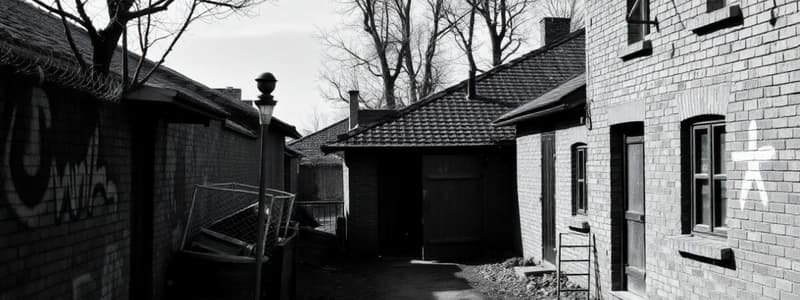Podcast
Questions and Answers
What was the primary cause of the anonymous girl's father's illness, as indicated in the diary?
What was the primary cause of the anonymous girl's father's illness, as indicated in the diary?
- Pneumonia
- Severe malnutrition
- Tuberculosis of the pharynx (correct)
- Typhus
What was the primary concern expressed in the entry dated March 11, 1942?
What was the primary concern expressed in the entry dated March 11, 1942?
- The fight with her father.
- The approaching winter season and lack of warm clothing.
- Her sister moving to Soviet Union.
- The declining quality and quantity of food rations. (correct)
What rumor was circulating in the ghetto, according to the March 4, 1942, entry?
What rumor was circulating in the ghetto, according to the March 4, 1942, entry?
- Construction of a new hospital to improve medical care.
- An increase in food rations was expected.
- The establishment of a new school for ghetto children was imminent.
- Possible deportations affecting either everyone or only welfare recipients and construction of a work camp. (correct)
What external symbol of oppression is mentioned in the March 14, 1942 entry, representing the loss of freedom?
What external symbol of oppression is mentioned in the March 14, 1942 entry, representing the loss of freedom?
The diary abruptly ends with the mention of deportations targeting which specific group?
The diary abruptly ends with the mention of deportations targeting which specific group?
What was the primary concern expressed by the diarist in her entries?
What was the primary concern expressed by the diarist in her entries?
The diarist mentions a note from her sister's friend. What was the purpose of this note?
The diarist mentions a note from her sister's friend. What was the purpose of this note?
What can be inferred about the diarist's family situation from the content?
What can be inferred about the diarist's family situation from the content?
Based on the diary entries, what was a significant factor contributing to the suffering within the Lodz Ghetto?
Based on the diary entries, what was a significant factor contributing to the suffering within the Lodz Ghetto?
What was the final fate of the people deported from the Lodz Ghetto, according to the background information?
What was the final fate of the people deported from the Lodz Ghetto, according to the background information?
Flashcards
Lodz Ghetto
Lodz Ghetto
A Jewish ghetto in Poland during WWII.
Conditions in the Ghetto
Conditions in the Ghetto
Arduous living conditions with severe food shortages and suffering.
Daily Diary Entries
Daily Diary Entries
Entries describing personal experiences and daily struggles.
Deportations to Chelmno
Deportations to Chelmno
Signup and view all the flashcards
Invasion of Poland
Invasion of Poland
Signup and view all the flashcards
Tuberculosis
Tuberculosis
Signup and view all the flashcards
Deportations
Deportations
Signup and view all the flashcards
Ghetto
Ghetto
Signup and view all the flashcards
Ration
Ration
Signup and view all the flashcards
Frostbite
Frostbite
Signup and view all the flashcards
Study Notes
Lodz Ghetto Diary of an Anonymous Girl
- Lodz Ghetto, Poland, was fully occupied by Germany
- Cut off from outside world, limited trade and smuggling opportunities
- Family included mother (machine operator), father (painter), sister (17), brother (16)
- Diarist likely youngest, not sent on work detail
- Family spoke Polish
- Diary's first entry undated, mid-sentence, possibly incomplete
Major Events
- September 1, 1939: German invasion of Poland
- Summer 1940: Jews deported to Lodz Ghetto
- December 7, 1941: Deportations from Lodz Ghetto to Chelmno Death Camp begin
- January-May 1942: 54,900 Lodz Ghetto residents gassed at Chelmno
- February 27-March 18, 1942: Diary entries
Living Conditions & Daily Struggles
- Extremely difficult living conditions during the time in the Lodz Ghetto
- Focused on daily struggles for food
- Frequent food shortages, rationing, and queues
- Detailed descriptions of food consumption, weight, and condition
- Record of deportations and significant suffering of others
Specific Entries:
- February 27, 1942: Expresses despair and outrage at suffering, deportations, and lack of food.
- February 28, 1942: Describes sister's friend's deportation, sister losing a brother and mother in the span of nine months, details their extreme poverty.
- March 4, 1942: Reports ongoing deportations, rumors of further deportations/work camps, anxieties grow inside the Ghetto.
- March 11, 1942: Notes poor quality of food rations, extreme hunger, illness, financial hardship amongst the family, and recounts a fight with father over food.
- March 14, 1942: Expresses longing for freedom and the harsh realities of life in the ghetto.
- March 18, 1942: Families being deported.
Fate of the Diarist and Diary
- Diary ends abruptly, midsentence
- Diarist fate unknown, presumed death with family and other ghetto residents
- Diary recovered in abandoned apartment in July 1945
Studying That Suits You
Use AI to generate personalized quizzes and flashcards to suit your learning preferences.


